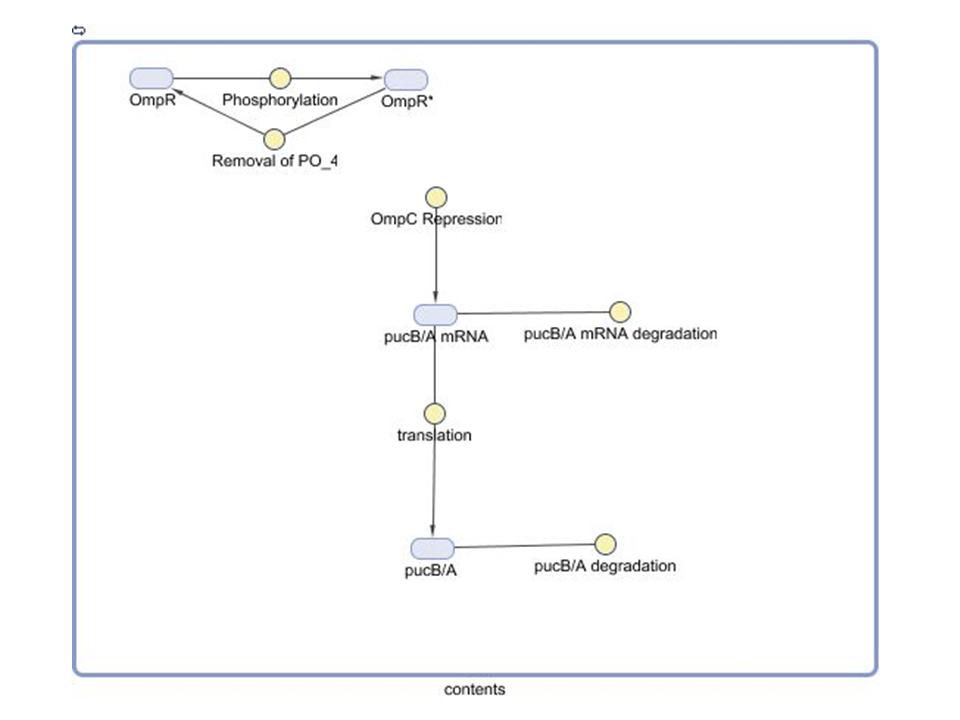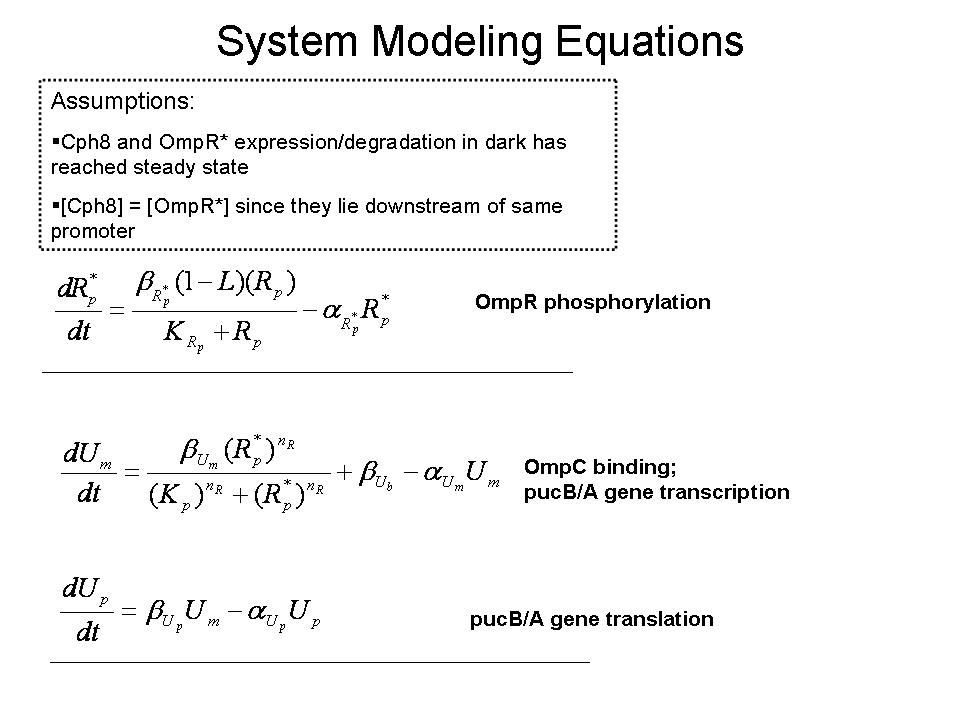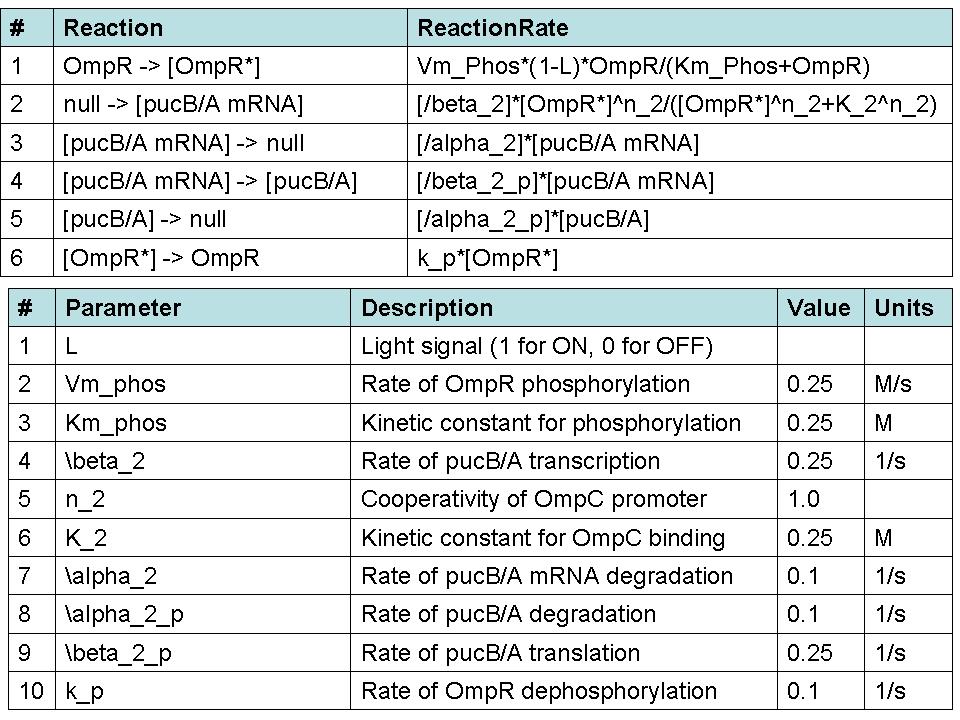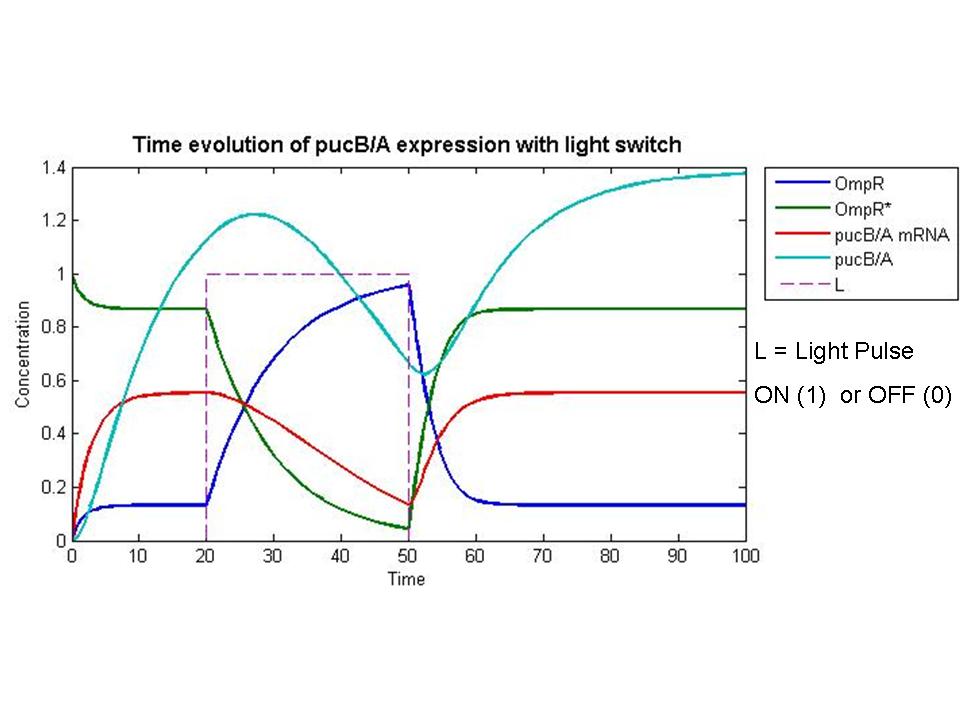Back To Top
Characterization
The first part of our characterization begins with the puc promoter. The puc promoter is what turns on the entire system naturally in
Rhodobacter sphaeroides. The puc promoter is what ultimately controls the number of LH2 light harvesting complexes, which is how our system will yield an increase in photosynthetic efficiency. It is important that we are able to compare the transcription rate of the puc promoter in the two systems so that we can determine exactly how much efficiency is gained by adding a red light sensor. By attaching Green Fluorescent Protein (GFP) to the promoter we can quantify the rate of transcription by measuring the emission of green light using a fluorescence spectrophotometer. We would expect to see more fluorescence with more transcription and vis versa.
The next step in our characterization of our synthetic red light response system is to analyze changes in phosphorylation of ompR in
Rhodobacter sphaeroides. In our final system, we only want puc genes to be transcribed and expressed via halting the autophosphorylation of ompR, not simply the puc promoter as it naturally occurs. By placing the ompR coding region downstream of the red light sensor and upstream of a terminator our modified system controls expression of the puc genes by the red light sensor. It should be impossible for the puc promoter to directly cause the transcription of puc genes due to the terminator, but instead, transcription of the puc genes must be activated via decreasing the presence of phosphorylated ompR. The end target of ompR transcription is the ompC promoter, located directly upstream of the puc genes. Placing GFP on the ompC transcript will show how often the promoter is transcribed and how often ompR is phoshorylated.

Part three of our characterization measures the effectiveness of the red light sensor in downregulating the phosphorylation of ompR. This setup is identical to that of part two except we have introduced the red light sensor. Now, the rate of ompR autophosphorylation will be halted by binding to a domain on the light-activated EnvZ kinase analogue. GFP is still attached to the end product, the ompC promoter. By comparing the fluorescence of GFP in this scenario compared with the second scenario the decrease in rate of phosphorylation should be apparent due to the activity of the red light sensor.
This is the final construct that will be our actual functioning model in
Rhodobacter sphaeroides. This finished product will be compared to the wild type over various intensities of light and cell culture densities can be compared to see which strain, the wild type or the modified strain with the red light sensor was more efficient in harvesting light with varying intensities.
Back To Top
Modeling

pucBA Expression Model Diagram
Modeling the Gene Regulatory Network
- Our group seeks to assess the optimality of the synthetic system that modulates pucB/A gene expression and LH2 complex assembly in Rhodobacter sphaeroides. Here we employ a mathematical model of this system to generate predictions about the behavior of the active system in response to light input. Features of the system that the model may help investigate include the time scale of response to light signals, the robustness of the system in response to fluctuations in light intensity, and the translation between changes in gene expression and the absorbance spectrum of the engineered cells.
- Though the context of the model can extend back to the transcription of PrrA/B genes involved in integration oxygen and light signals, a preliminary testing model was developed using assumptions of certain initial conditions to isolate the light signal's effect. Since Cph8 and OmpR are located on the same transcript downstream of the puc promoter region, it was assumed that their associated protein and mRNA had already reached steady state concentrations, and the phosphorylation reaction had already reached steady state. Moreover, the concentrations of the factors were assumed to be equal at this state. The model whose diagram was constructed in the Simbiology Toolbox distributed by MathWorks details key reactions leading to the translation of the pucB/A genes. The reaction rate equation used for the lack of phosphorylation of OmpR when the light signal reaches Cph8 bound to OmpR is captured in a modified form of Michaelis-Menten kinetics. A logic function that corresponds to light ON/OFF (1/0) multiplies the maximum reaction rate in the numerator of the phosphorylation equation. Thus, the model assumes that no phosphorylation occurs by this mechanism in the presence of light. The OmpC promoter binding equation was based on the Hill Equation for an Activator(1).
- Component characterization steps and literature searches are underway in order to obtain quantitative parameters for the reaction rates. In order to simulate behavior of the system, putative values were included that exaggerate true concentrations and time scales. OmpR was given an initial concentration normalized to one, and all other components were assumed insignificant initially to this value. An ideal light pulse was introduced at an instant and removed thirty simulation seconds later. From this rudimentary simulation it can be drawn that the nonlinearities of the phosphorylation and transcription factor binding kinetics effectively smooth the sharp light input. By design, the light switch ON yields no phosphorylation of OmpR and repression of the pucB/A genes which would give rise to LH2. Conversely, when left OFF, the concentration of pucB/A recovers and increases until the steady state determined by its translation and degradation rates.
References
1. Alon, Uri. Introduction to systems biology and the design principles of biological networks. Boca Raton, FL: Chapman & Hall, 2006.
2. Bower, James M. Computational Modeling of Genetic and Biochemical Networks (Computational Molecular Biology). New York: M.I.T. PRESS, 2001.
3. System modeling in cellular biology from concepts to nuts and bolts. Cambridge, MA: MIT P, 2006.
Simulating a Bioreactor
Back To Top

 "
"








